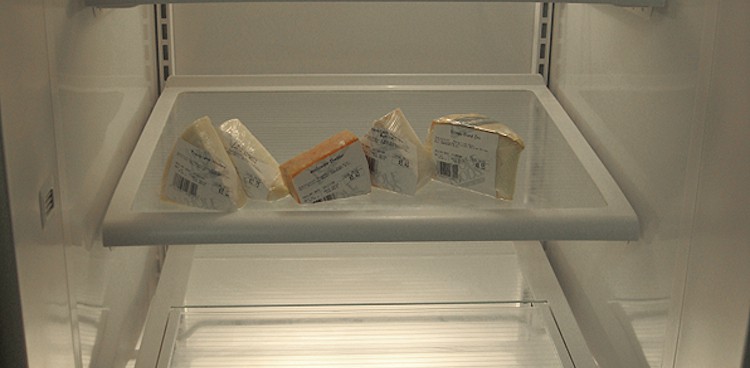
First of all, bear in mind that cheese is a living thing. It needs to breathe, so should be treated much in the same way as produce or meat. Imagine how you would feel wrapped in Cling Wrap and thrown in the fridge for days! If the cheese you purchase is cut to order, ask for it to be wrapped in wax paper. Wrapping cheese in paper allows it to breathe. Ask if the store might be willing to give (or sell) you a few extra sheets so that you can rewrap the cheese at home after opening. You can also use parchment paper at home.
Before placing the cheese in the refrigerator, cover the outside of the wax paper with plastic wrap and place the entire thing in a small cardboard or wooden box with a lid; this will help the cheese avoid cold drafts while retaining moisture. If a wood or cardboard box isn’t available, use a plastic container with a lid.
Ideally, place the cheese in the salad or vegetable drawer. Moisture given off by the vegetables will help to the cheese stay hydrated.
Check the cheese daily. If it appears wet and soggy, it needs more air; if it’s drying out, introduce moisture by wrapping it with a damp (not wet), clean, cloth and place it in a plastic container.
Try to keep similar types of cheeses together—washed rinds (stinkies) with washed rinds, blues with blues—and in their own containers, if possible.
When storing softer cheeses, it’s a good idea to flip them upside down. This allows moisture to remain evenly distributed throughout the cheese and prevents sogginess on any one side.
The exception to the above lies in storing very fresh cheeses, such as fresh goat cheese, ricotta, or cream cheese; these need to be kept in the same way as milk or yogurt in order to preserve their freshness. Keep these cheeses in their individual containers, as close to 38° to 40° F as possible.
Feature Photo Credit: Aubrey Sun via Compfight cc




